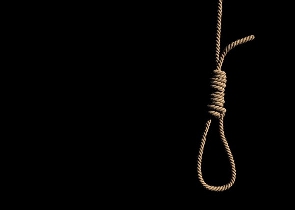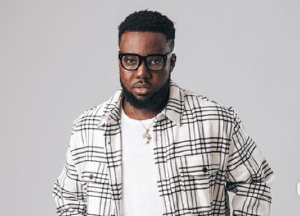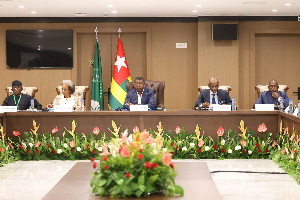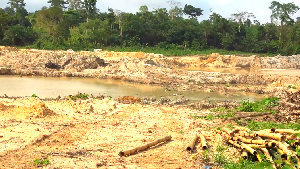By Kwame Okoampa-Ahoofe, Jr., Ph.D.
The trip to City Hall from Brooklyn's Boys' and Girls' High School was not an easy one by any measure - and on this score, of course, absolutely no pun, whatsoever, is intended. It was no cake-walk, as New Yorkers are wont to say. Much of the proceedings appeared to have already transpired by the time that my team and I arrived. But it also clearly appeared that there was still much more left to go. The forecourt of City Hall was so jam-packed with spectators that one could hardly move an inch without stepping on the toes of another.
My team members and I had our press tags around our necks and so could readily be recognized as bona fide members of the New York City press corps. Orlando McAllister had secured us these passes. Orlando was such a human dynamo as to have made everything much easier for the team than it could have been. He was a graduate student in one of the graduate programs at CCNY and was employed in clerical work, as I recall, in the School of Architecture, or some such division located in Shepard Hall, the largest gothic landmark on campus.
Orlando, a half African-American and Hispanic, of either Dominican or Puerto Rican heritage and nationality, or both, I forget exactly which, had undertaken his undergraduate media and communication studies at Howard University, Washington, D.C., the famous African-American flagship academy in the nation's capital. And it was clearly this aspect of his quite considerable learning that had brought the two of us together. Orlando was often to be seen on campus, during his leisure hours, sporting a video camera, or camcorder, and covering on-campus activities.
I don't quite recall exactly how we had come into contact with each other. We might have been introduced to each other, perhaps, by a mutual friend. Whatever be the case, Orlando and I had almost immediately taken a great liking to each other. Orlando also seemed to admire the fact that I was freelancing for the New York Amsterdam News, the most notable African-American weekly in the northeastern United States; he also admired what he termed as my "hard hitting and eloquent" weekly columns in CCNY's Campus newspaper, for which he must, himself, have penned and published an article or two.
We asked to be shown the press section by somebody in the audience and were pointed in a direction that was as good as none. It didn't make sense to us; for it was no real or definitive direction at all, largely being that the oceanic wave of crowd barely made even the podium up the steps of City Hall visible. About the only recognizeable press personality we could see was the now-late Reggie Harris, a television news anchor and reporter with WWOR-TV, New York City's Channel 9. Reggie Harris (1953-2000) had also worked with WCBS-TV, the city's Channel 2. But even more significantly, Reggie Harris was also known to be the tallest Tri-State Area television news anchor and reporter.
On this historic day, however, even a giant media man like Reggie Harris would easily have been swallowed up by the Tsunami-like crowd of many-thousand spectators massed up the forecourt of City Hall. The throng easily numbered between one-hundred and two-hundred thousand. Several streets in the vicinity had been closed and cordoned off by members of the New York City Police Department (NYPD), to make room for the human spillage which looked to be even in far greater numbers than those inside the forecourt of City Hall itself. We readily spotted Reggie Harris because he had mounted the canopy of the van of the news channel for which he worked and was providing footage-accompanied commentary for the millions of viewers glued to their TV sets at home, in restaurants and beer bars, and in offices and other public buildings and spaces with a boob-tube, as it were. It appeared that Reggie had camped out on the grounds when everybody was in bed and marked out a prime spot for his reportage of this historic event. Those who knew him said he was incurably workaholic; and, in fact, in the afternoon of his death, it was widely reported that he was working out on his home-fitted treading machine, obviously to keep himself tuned-up and in shape, when he collapsed.
As we hustled our way through the crowd, we could delightfully hear the familiar voice of New York State's faultingly liberal, some of his critics claimed, and anti-death penalty governor, Mario Cuomo, boom over the loudspeakers, "We must use every reasonable and effective device we can find to end apartheid, until it becomes only a terrible memory." I had always deemed New York State's Big Kahuna to be one of the smartest living statesmen and politicians in the United States. I knew that unlike the other glad hands, Gov. Cuomo meant exactly what had come across to us from the loudspeakers.
Then either Orlando, or our cameraman whose name twenty-three years of temporal distance seems to have completely erased from my memory bank, suggested that we go through the right-, or west-, side and then the back of City Hall. It seemed like a very sensible idea amidst the breathless and humid crush. We quickly obliged, since the crowd also appeared to be remarkably thinner in these parts. Soon, we were inside the building. But that was just the beginning of our "struggle" towards our global symbol of freedom.
Having only espied City Hall many times before from the outside, I had not noticed that the building was actually a fort- or castle-like concatenation of several buildings. And so the problem that confronted us was which way to turn. We were rooted to the transept of four plushly carpeted hallways. None on our team had been inside City Hall. I had only once reported a press conference held by the now-late Congressman Major Owens, of Brooklyn, for the New York Amsterdam News; and that was three years before, and I had only been in the United States for just two years. I had hoped that at least my more native associates, namely, Orlando and our camera and sound men would be a bit more familiar with the people's house. Alas, I was darn mistaken, and miserably so. I cursed at no one in particular under my breath.
I made a split-second decision and promptly communicated the same to the members of my team. We would not let on the fact of our total lack of familiarity with the inside of City Hall, or we shall soon find ourselves thrown out and back amidst the crush of human waves in the forecourt of City Hall; or worse yet, even get arrested for criminal trespassing in a highly sensitive security zone. In retrospect, it clearly appears that it was my African garb and our press ID that had done the trick, as it were.
Anyway, we took the red-carpeted hallway straight ahead, the one that looked to be pointing eastward and were able to literally zoom through three heavily fortified security checkpoints, and were easily within eight or ten meters from a jet-black colored jumbo limousine, apparently set aside for The Madiba's special use, when an NYPD officer approached us, pistol in holster, saluted and politely demanded of our mission.
"Are you with Mr. Mandela?" The question sounded a little bit amusing, being that we had our press passes, which clearly identified us as bona fide members of the New York Press, around our necks.
"No," I shook my head and added, "Officer, we are looking for the press stand." The NYPD man returned my nod knowingly and politely pointed us towards a more sparsely populated route to the press stand.
At all three checkpoints, we had been genuflected to by the NYPD security detail who clearly appeared to have mistaken my team and me for a South African press corps. I later joked to my teammates that we could easily have extinguished the living daylights out of most of New York City and State's most powerful personalities that day before any of them would have been able to scream "Tyson!" For we had been less than thirty meters from where Mandela, Mayor Dinkins, Governor Cuomo, Ex-Mayor Edward Koch and all the other political titans of New York City and New York State had been comfortably seated, with their backs facing us from the right side of the front of the building. I also began to feel a bit worried about the much-touted hermetic security cordon supposedly mounted around Africa's man of the hour and moment.
By the time that we took our vantage positions on the press stand, on the left scaffolding across from the podium under the trees, it was the turn of The Madiba. This was the moment we had been fervidly hoping not to miss. In his trademark deliberately dignified manner, the greatest and bravest African political prisoner, prison graduate and freedom fighter rose to the podium and began in his booming and sonorous voice, "Today, we can say with confidence that we can see the light at the end of the tunnel." A few scattered surges of applause rippled through the crowd. Then he added, to a hurricane of deafening approbation, "Apartheid is doomed. South Africa shall be free!" The latter declaration instantly evoked fond memories of former President Kenneth Kaunda's political classic, Zambia Shall Be Free, which was part of my General Certificate of Education (GCE), Ordinary Level, set of English Literature textbooks.
___________________________________________________________________________
*Kwame Okoampa-Ahoofe, Jr., Ph.D.
Department of English
Nassau Community College of SUNY
Garden City, New York
Dec. 23, 2013
E-mail: okoampaahoofe@optimum.net
###
Opinions of Friday, 27 December 2013
Columnist: Okoampa-Ahoofe, Kwame














